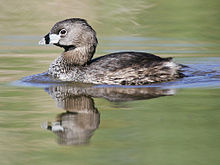Pied-billed grebe
| Pied-billed grebe | |
|---|---|
 |
|
| Summer plumage | |
| Scientific classification | |
| Kingdom: | Animalia |
| Phylum: | Chordata |
| Class: | Aves |
| Order: | Podicipediformes |
| Family: | Podicipedidae |
| Genus: | Podilymbus |
| Species: | P. podiceps |
| Binomial name | |
|
Podilymbus podiceps (Linnaeus, 1758) |
|
 |
|
| Distribution of the pied-billed grebe | |
The pied-billed grebe (Podilymbus podiceps) is a species of the grebe family of water birds. Since the Atitlán grebe (Podilymbus gigas) has become extinct, it is the sole extant member of the genus Podilymbus. The pied-billed grebe is primarily found in ponds throughout the Americas. Other names of this grebe include American dabchick, dabchick, Carolina grebe, devil-diver, dive-dapper, dipper, hell-diver, pied-billed dabchick, pied-bill, thick-billed grebe, and water witch.
The pied-billed grebe was described by Carl Linnaeus in the 10th edition of his Systema Naturae in 1758 as Colymbus podiceps. The binomial name is derived from Latin Podilymbus, a contraction of podicipes ("feet at the buttocks", from podici-, "rump-" + pes, "foot")—the origin of the name of the grebe order—and Ancient Greek kolymbos, "diver", and podiceps, "rump-headed", from podici- + New Latin ceps.
Outside its own genus, the closest relatives of the pied-billed grebe are the small grebes of the genus Tachybaptus.
Pied-billed grebes are small, stocky, and short-necked. They are 31–38 cm (12–15 in) in length, with a wingspan of 45–62 cm (18–24 in) and weigh 253–568 g (8.9–20.0 oz). They are mainly brown, with a darker crown and back. Their brown color serves as camouflage in the marshes they live in. They do not have white under their wings when flying, like other grebes. Their undertail is white and they have a short, blunt chicken-like bill that is a light grey color, which in summer is encircled by a broad black band (hence the name). In the summer, its throat is black. There is no sexual dimorphism. Juveniles have black and white stripes and look more like winter adults. This grebe does not have webbed feet. Its toes have lobes that come out of the side of each toe. These lobes allow for easy paddling. When flying, the feet appear behind the body due to the feet's placement in the far back of the body.
...
Wikipedia

